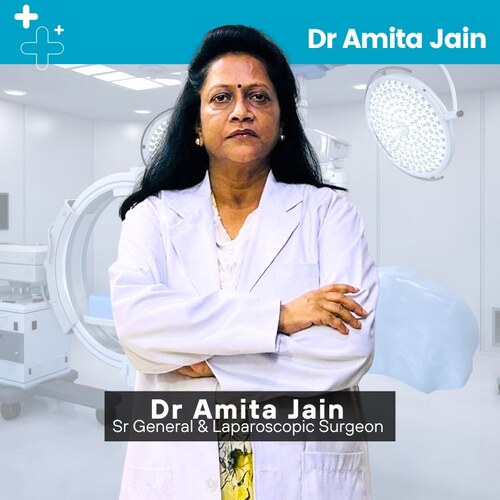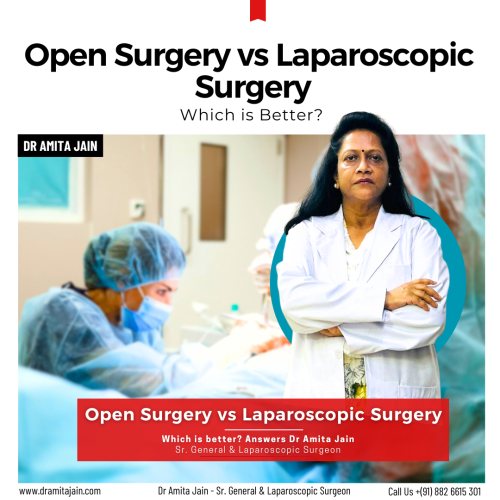Advances in medical technology have transformed the way surgeries are performed. Among the most common approaches today are open surgery and laparoscopic surgery. Both methods have their own roles in patient care, and understanding their differences helps patients make informed choices together with their doctor says Dr Amita Jain who is one of the leading Senior general and laparoscopic surgeon in Delhi and India.
What is Open Surgery?
Open surgery is the traditional form of surgery where a large incision is made to directly access the affected organ or tissue. For instance, in an abdominal operation, the surgeon creates a significant cut to expose the organs inside.
Characteristics of Open Surgery:
- Direct visibility and access: Surgeons can see and handle the organs with their own eyes and hands.
- Suitable for complex cases: Especially helpful in trauma, large tumor removal, or surgeries where precision and space are required.
- Recovery: Because of the larger incision, patients usually experience more pain, a higher risk of infection, and longer hospital stays.
- Scarring: Open surgery often leaves visible scars, which may also affect recovery time.
What is Laparoscopic Surgery?
Laparoscopic surgery, often called minimally invasive surgery, uses very small incisions. Through these cuts, a laparoscope (a thin tube with a camera) and surgical instruments are inserted. The surgeon operates by viewing magnified images on a monitor.
Characteristics of Laparoscopic Surgery:
- Small incisions: Typically less than one centimetre, causing less trauma to the body.
- Faster recovery: Patients often go home sooner and return to normal activities quickly.
- Less pain and infection risk: Small wounds reduce complications.
- Cosmetic benefit: Scars are tiny and fade with time.
- Common uses: Gallbladder removal, hernia repair, appendectomy, bariatric surgery, and gynaecological operations.
Comparing the Two Approaches
While both methods aim to achieve the same medical outcome—treating the condition—they differ in how they affect patients and surgeons alike.
Recovery and Hospital Stay
Patients undergoing laparoscopic surgery usually recover faster and spend fewer days in the hospital compared to those who have open surgery. Open surgery, with its larger incisions, generally requires longer healing time.
Pain and Comfort
Post-operative pain tends to be higher in open surgery because of the larger wound. Laparoscopic procedures usually cause less discomfort, allowing patients to regain mobility sooner.
Scarring and Appearance
The cosmetic difference is significant. Open surgery leaves bigger, often permanent scars, whereas laparoscopic scars are small and discreet.
Suitability for Different Cases
Not every condition can be treated laparoscopically. Complex or emergency situations—such as severe trauma, large tumors, or uncontrolled internal bleeding—may require open surgery because it provides surgeons with full access to the area. Laparoscopic surgery, on the other hand, is highly effective for routine and less complicated procedures.
Risks and Safety
Both surgeries carry risks. Open surgery may involve greater blood loss, infection risk, and longer anesthesia time. Laparoscopic surgery, while generally safer, depends heavily on the surgeon’s skill and can involve rare complications like accidental injury from instruments.
Conclusion
There is no absolute “better” between open surgery and laparoscopic surgery—each has its own importance. Laparoscopic surgery is preferred when minimally invasive methods are sufficient, offering faster recovery, less pain, and better cosmetic results. Open surgery, however, remains crucial for complicated cases, emergencies, or when direct access is necessary.
The best approach depends on the patient’s condition, overall health, and the surgeon’s judgment. In modern practice, both techniques complement each other, ensuring patients receive safe and effective treatment tailored to their needs

Dr Amita Jain is one of the most experienced and highly skilled general and laparoscopic surgeons in Delhi and India. Known for her exceptional surgical precision and patient-first approach, she offers expert care across a wide range of procedures, using both open and minimally invasive techniques to ensure faster recovery and better outcomes. Dr Amita Jain holds 28 plus years of rich experience in Trauma and General Laparoscopic Surgeries (including Gallbladder stone removal, appendix removal, hernia repair surgery, piles and fissure surgeries). She was the Professor Surgery of at the Army College of Medical Sciences. In 1994 she was commissioned as Surgeon under the United Nations Mission in Congo. From 2020 to 2022, she worked with Bansals Hospital. Currently, Dr Amita Jain is the Sr. General and Laparoscopic Surgeon at Rainbow Children Hospitals, Malviya Nagar, Delhi.
As a top female surgeon in Delhi, Dr Amita Jain brings decades of experience, compassion, and a commitment to surgical excellence. She has undergone advanced training in trauma surgery and has successfully performed numerous complex procedures, including life-saving surgeries, vascular repairs, mangled limb reconstructions, and critical care surgeries. Whether it’s a planned surgery or an emergency situation, patients across Delhi trust Dr Amita Jain for her expertise, integrity, and results-driven approach to general and laparoscopic surgery.
Call Us at +(91) 882-6615301
